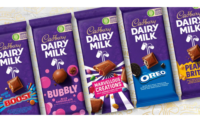Iconic brands require exceptional marketing performance, and achieving exceptional marketing performance requires a well-designed, efficient marketing ecosystem. An efficient marketing ecosystem hums with productivity, where stakeholders across the supply chain work in tandem to carry projects from ideation all the way through to adaptation, production and final print in a single, centralized workstream. And it provides connectivity and scalability across stakeholders, SKUs, brands and geographies.
So how does a brand achieve this level of efficiency across its marketing ecosystem?
Let’s look at SGK’s partnership with Mondelēz International to deploy the redesigned Cadbury brand in APAC to highlight a few key strategies.
A Collaborative Mindset
An efficient marketing ecosystem requires all stakeholders working towards a common goal. Open communication is key. The Cadbury relaunch required SGK to collaborate with Mondelēz stakeholders, their design agency and print partners to identify critical elements that would impact the final printed packaging. Approximately 48 different print options were prepared to explore and achieve the original design intent.
David Pegg, Mondelēz Design Operations lead, AMEA, noted that “SGK have been very proactive aligning and effectively communicating the process to the various Mondelēz markets and also within their own production centres across our AMEA region. Working with a strong interconnected team eased our concerns of achieving the right consistency of the packaging and conserving the key brand equity elements. And I’d like to congratulate the team for delivering the project within the launch timelines for ANZ with further roll outs planned for SEA, South Africa, and Egypt in 2020.”
A Consultative Approach
Implementing an efficient marketing ecosystem requires a consultative approach to all aspects of the process, and continuous improvements. For Cadbury, this meant preplanning and addressing all of the detailed technical specifications of the brand while respecting the creative strategy that Mondelēz and their design agency developed.
Says Bree Ford, SGK’s senior account manager for Mondelēz,“We worked with Cadbury stakeholders to determine areas of focus for our technical teams. Based on our diagnostic work, we knew that protecting brand color and consistency would be the key focus of our production process. This diagnostic work ultimately helped protect the Cadbury Dairy Milk brand at every stage as it was launched across the ANZ markets. This launch helped Cadbury retain consumer recognition and quality perception.”
SGK paid special attention to technical specifications so that we could achieve print consistency across the Australia and New Zealand (ANZ) Cadbury markets — ensuring clear definition of the iconic Cadbury purple color and key brand assets. This focus on accuracy was reflected not only through packaging but also across the Cadbury ecosystem, including digital platforms, social media, and eCommerce content, as we rolled out more than 70 items within the ANZ market.
An Efficient Partnership
Mondelēz, SGK, Design Agencies and Printers were the partners on this project. The final piece to an efficient marketing ecosystem is an efficient partnership, one that anticipates challenges in advance to enable higher productivity across the supply chain. For Mondelēz, this meant recognizing and mitigating print challenges before they occurred.
SGK’s team in ANZ undertook a detailed process of preparing scatter proofs, working with printers and educating them on technical aspects during the production process to avoid costly interruptions on press. Evaluating the print execution helped reduce the overall print costs for Mondelēz, created efficiencies at the print partners, and ultimately kept to the timeline for the launch.
The specific components for an efficient marketing ecosystem can be different for every brand owner. For Cadbury in APAC, the components focused on color and print accuracy to drive brand consistency across markets.







